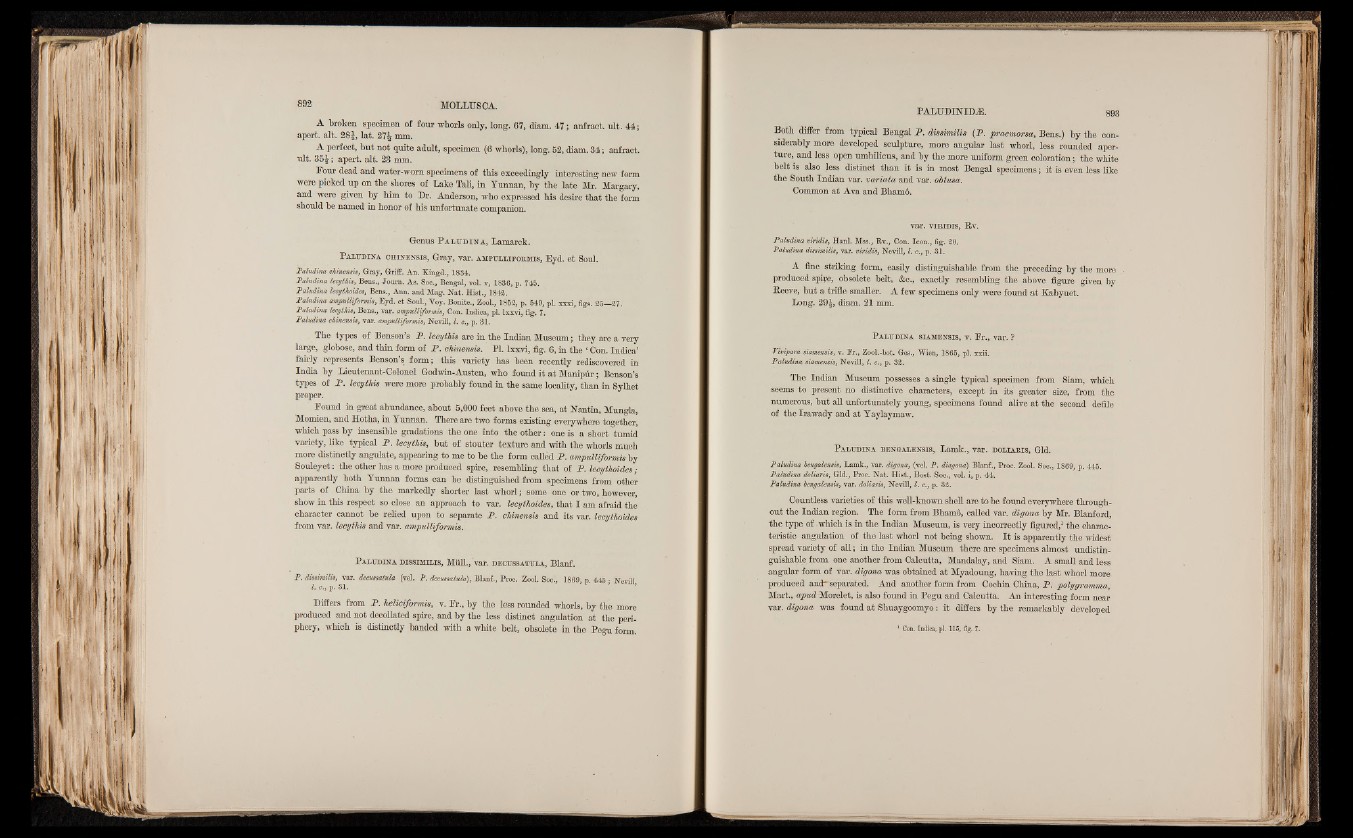
A broken specimen of four whorls only, long. 67, diam. 47; anfract. ult. 44;
apert. alt. 28|, lat. 27£ mm.
A perfect, but not quite adult, specimen (6 whorls), long. 52, diam. 34; anfract.
ult. 35£; apert. alt. 23 mm.
Pour dead and water-worn specimens of this exceedingly interesting new form
were picked up on the shores of Lake Tali, in Yunnan, by the late Mr. Margary,
and were given by him to Dr. Anderson, who expressed his desire that the form
should be named in honor of his unfortunate companion.
Genus P a l u d i n a , Lamarck.
P a l u d i n a c h i n e n s i s , Gray, var. a m p u l l i f o r m i s , Eyd. et Soul.
Paludina chinensis, Gray, Griff. An. Kingd., 1834.
Paludina lecythis, Bens., Journ. As. Soc., Bengal, vol. v, 1886, p. 745.
Paludina lecythoides, Bens., Ann. and Mag. Nat. Hist., 1842.
Paludina ampulliformis, Eyd. et Soul., Voy. Bonite., Zool., 1852, p. 549, pi. xxxi, figs. 25—27.
Paludina lecythis, Bens., var. ampulliformis, Con. Indica, pi. lxxvi, fig. 7.
Paludina chinensis, var. ampulliformis, Nevill, I. c., p. 81.
The types of Benson’s P. lecythis are in the Indian Museum; they are a very
large, globose, and thin form of P . chinensis. PI. lxxvi, fig. 6, in the ‘ Con. Indica’
fairly represents Benson’s form; this variety has been recently rediscovered in
India by Lieutenant-Colonel Godwin-Austen, who found it at Manipùr ; Benson’s
types of P . lecythis were more probably found in the same locality, than in Sylhet
proper.
Pound in great abundance, about 5,000 feet above the sea, at Nantin, Mungla,
Momien, and Hotha, in Yunnan. There are two forms existing everywhere together,
which pass by insensible gradations the one into the other : one is a short tumid
variety, like typical P . lecythis, but of stouter texture and with the whorls much
more distinctly angulate, appearing to me to be the form called P. ampulliformis by
Souleyet: the other has a more produced spire, resembling that pf'P. lecythoides ;
apparently both Yunnan forms can be distinguished from specimens from other
parts of China by the markedly shorter last whorl ; some one or two, however,
show, in this respect so close an approach to var. lecythoides, that I am afraid the
character cannot be relied upon to separate P . chinensis and its var. lecythoides
from var. lecythis and var. ampulliformis.
P a l u d i n a d i s s im i l i s , Mull., var. d e c u s s a t u l a , Blanf.
P. dissimilis, var. decussatula (vel. P. decussatula), Blanf., Proc. Zool. Soc., 1869, p. 445 • Nevill
I. c., p. 31.
Differs from P. heliciformis, v. Pr., by the less rounded whorls, by the more
produced and not decollated spire, and by the less distinct angulation at the periphery,
which is distinctly banded with a white belt, obsolete in the Pegu form.
Both differ from typical Bengal P . dissimilis (P. praemorsa, Bens.) by the considerably
more developed sculpture, more angular last whorl, less rounded aperture,
and less open umbilicus, and by the more uniform green coloration; the white
belt is also less distinct than it is in most Bengal specimens; it is even less like
the South Indian var. variata and var. obtusa.
Common at Ava and Bham6.
var. v i r i d i s , Rv.
Paludina viridis, Hanl. Mss., Rv., Con. Icon., fig. 20.
Paludina dissimilis, var. viridis, Nevill, I. c., p. 81.
A fine striking form, easily distinguishable from the preceding by the more
produced spiye, obsolete belt, &c., exactly resembling the above figure given by
Reeve, but a trifle smaller. A few specimens only were found at Kabyuet.
Long. 29|, diam. 21 mm.
P a l u d i n a s ia m e n s i s , v . Pr., var. ?
Vivipara siamensis, v. Fr., Zool.-bot. Ges., Wien, 1865, pi. -nm
Paludina siamensis, Nevill, I. c., p. 32.
The Indian Museum possesses a single typical specimen from Siam, which
seems to present no distinctive characters, except in its greater size, from the
numerous, but all unfortunately young, specimens found alive at the second defile
of the Irawady and at Yaylaymaw.
P a l u d i n a b e n g a l e n s i s , Lamk., var. d o l ia r i s , Gld.
Paludina bengalensis, Lamk., var. digona, (vel. P . diagona) Blanf., Proc. Zool. Soc., 1869, p. 445.
Paludina doliaris, Gld., Proc. Nat. Hist., Bost. Soc., vol. i, p. 44.
Paludina bengalensis, var. doliaris, Nevill, I. c., p. 82.
Countless varieties of this well-known shell are to be found everywhere throughout
the Indian region. The form from Bhamd, called var. digona by Mr. Blanford,
the type of which is in the Indian Museum, is very incorrectly figured,1 the characteristic
angulation of the last whorl not being shown. I t is apparently the widest
spread variety of all; in the Indian Museum there are specimens almost undistin-
guishable from one another from Calcutta, Mandalay, and Siam. A smnll and less
angular form of var. digona was obtained at Myadoung, having the last whorl more
produced and-separated. And another form from Cochin China, P. poly gramma,
Mart., apud Morelet, is also found in Pegu and Calcutta. An interesting form near
var. digona was found at Shuaygoomyo: it differs by the remarkably developed
1 Con. Indica, pi. 115, fig. 7.